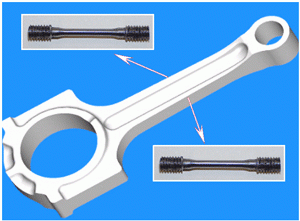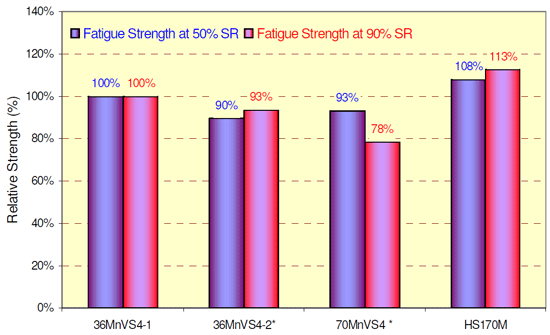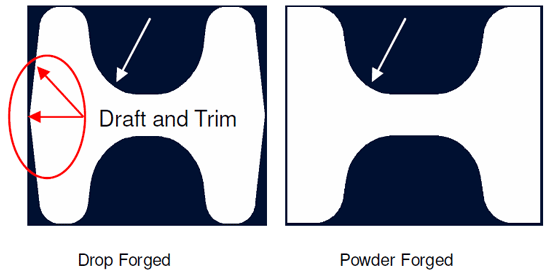Advances in high strength PM materials help powder forged connecting rods gain market share
Metaldyne, which was acquired by American Securities LLC in December 2012, is reported to have sales over $1 billion from its 25 manufacturing facilities in 13 countries in North and South America, Europe and Asia.
Dr Ilia stated that the company has been producing PF connecting rods since 1986, and today supplies around 50 million finished, machined and assembled fracture-split PF rods annually to more automotive engine programmes than any other PM manufacturer. He stated that PF connecting rods now have around 25% of the total automotive connecting rod market.
One of the most important driving forces for acceptance of the PF connecting rod by the automotive industry is cost savings. Dr Ilia said that conventional forging produces a significant amount of flash on the rod which has to be machined off. In the case of an average weight connecting rod this can mean removing some 320 g of steel from the forging in order to get to the finished shape connecting rod weighing around 500 g. This compares with only 90 g machined off the PF connecting rod which has minimal flash and therefore considerably reduces machining costs.
A further significant driving force is that powder-based steel alloys have not only kept pace with the recently introduced high strength microalloyed direct forged (DF) steel materials in terms of mechanical properties, but that the PF materials have been shown to possess higher fatigue properties.
Dr Ilia commented that the higher fatigue strength in the PF steel material has allowed an optimising of the design of the I-beam geometry to maximise the stiffness and bending ratio by taking full advantage of the strength-to-mass ratio of the PF steel alloy. This in turn has allowed a reduction in reciprocating and rotating mass – a key in helping to improve engine fuel efficiency, or to employ higher loads in service.
Another major advantage of the powder forging process is the ability to control weight of connecting rods to close tolerances. Conventionally hot forged connecting rods have considerable weight variation, and PF rods can eliminate the weight grading that often occurs at automotive engine plants.
Powder forged material optimisation
Key to the ongoing success of PF connecting rods, stated Dr Ilia, was the optimisation of the alloying contents in the PM Fe-Cu-C material which has resulted in significant improvements in static and dynamic properties. The recently optimised high strength PF materials have Cu contents ranging from 3% to 3.5% (grades HS150M, HS160M, and HS170M) and these are said to be more robust to graphite segregation than materials with 2% Cu and 3% Cu content.
For example, P/F-11C50 specified in MPIF Standard 35, has a high relative variation in strength (approx. 25%) within the specified limits for Cu (± 0.20%) and as-forged carbon (± 0.05%), when two extreme conditions are considered (low carbon/low copper and high carbon/high copper).
Dr Ilia reported that the introduction of high strength PF materials with increased Cu content reduced that variation to almost half (from 25% to 13%), and the optimisation of the Cu content (to 3.25%), helped to further reduce the variation in strength to only 8.5% (approx. 1/3 of the variation observed in P/F-11C50).
The chemical composition of the strongest HS modified material (HS170M) is shown in Table 1, where for comparison purposes, the standard material P/F-11C50 is also shown. Dr Ilia also stated that lowering the C content reduced the deformation resistance of the PF material during forging (at 850-900C) thereby significantly reducing microporosity at or near the surface.
In an effort to keep up with advances in PF connecting rods, the steel forging industry first introduced high strength microalloyed steels, such as 70MnVS4 and 80MnVS5, which brought improvements in fatigue strength over conventional C70 (AISI 1070) steels by 15% and 20% respectively. Further improvements in the performance of drop forged (DF) connecting rods, came with the introduction of two further materials 46MnVS6mod (0.48% C, 0.63% Si, 1.02% Mn, 0.26% Cr, 0.20% Ni, and 0.13% V) and 70MnVS4high (0.70% C, 0.20% Si, 0.83% Mn, 0.15% Cr, 0.14% Ni, and 0.19% V).
In these materials, due to lower carbon content, it is reported in the literature that “a basically pearlitic microstructure is obtained with increased portion of ferrite compared to C70S6. Also, these steel grades achieve higher strength by increasing manganese content and selecting suitable alloying elements for precipitation hardening.”
Ultimate tensile values of 1157 MPa and 1217 MPa and yield strength values of 849 MPa and 823 MPa were obtained for 46MnVS6mod and 70MnVS4high, respectively, using specimens machined from the I-beam of DF connecting rods. The fatigue strength (Ps = 50%) was reported as 543 MPa for 46MnVS6mod and 496 MPa for 70MnVS4high.
Dr Ilia stated that the mechanical properties for high strength PF materials have normally been reported from specimens machined from the bolt boss area of PF connecting rods, where the material density is usually slightly lower than in the I-beam. However, due to a lower degree of shape change during the forging process, strengthening and hardening are less pronounced in the bolt boss area than in the I-beam.
Therefore, mechanical properties obtained from specimens machined from the bolt boss area are consistently lower than those obtained from specimens machined from the I-beam and Dr Ilia stated that, as a result, do not represent the real performance of the strengthened and hardened PF material after forging. In order to more properly characterise the strength of PF HS170M and to provide a more accurate comparison with DF materials, cylindrical specimens, as shown in Fig. 1, were machined from the sides of the I-beam of PF connecting rods manufactured under mass production conditions.
As shown in Table 2, the mechanical properties of all of these materials obtained from specimens machined from the I-beam of connecting rods are quite similar. In the case of PF HS170M these results represent the mean values of fifteen tests. Dr Ilia said that as expected, the mechanical properties of HS170M obtained from the specimens machined from the I-beam are higher than the mechanical properties obtained from the bolt boss area.
Dr Ilia further reported on the fatigue testing PF connecting rods manufactured with HS170M and processed under optimised shot peening conditions, and compared them with the DF materials. The fatigue performance of these connecting rods was evaluated at two different stress ratios, r = -2.5 and r = -1 and compared to the fatigue performance of DF connecting rods.
As shown in Table 3, PF connecting rods manufactured with HS170M sustained higher stresses during fatigue testing than their DF counterparts. Furthermore, DF connecting rods manufactured with 70MnVS4 demonstrated a larger scatter than the other two groups of DF connecting rods manufactured with 36MnVS4.
On average, these scatter values are higher when compared to scatter values obtained during fatigue testing of PF connecting rods, as also shown in Table 3. Dr Ilia explained that the reason for the high scatter encountered during fatigue testing of DF connecting rods was the presence of several manufacturing flaws, in particular along the trim line.
The fatigue strength at 50% SR is higher in the case of connecting rods manufactured with PF HS170M than in the case of connecting rods manufactured with 70MnVS4 (by 15.7%) and 36MnVS4-1 and 36MnVS4-2 (by 7.4% and 20%, respectively). However, when the fatigue strength at 90% SR is compared, due to a tighter scatter, PF connecting rods manufactured with HS170M perform much better than DF connecting rods manufactured with 70MnVS4 (by 43.9%) and 36MnVS4-1 and 36MnVS4-2 (by 12.5% and 20.6%, respectively), as illustrated in Fig. 2.
Dr Ilia concluded that as a near net forming process, PF provides the opportunity for optimal balance between strength, stiffness, and total mass, thus maximizing the strength-to-mass ratio. Unlike DF connecting rods, the I-beam section on PF connecting rods is smooth, without draft angles or trim lines. Furthermore, the inner radius in the web, shown by arrows in Fig. 3, can be smaller in the case of PF connecting rods, thus making possible a better mass distribution in the outer corners of the section where its contribution to stiffness is higher.
In addition, PF connecting rods offer several other advantages over DF connecting rods, such as higher material utilisation efficiency, better weight variation (very important for the NVH quality), better machinability and less machining operations, lower deformability in the crank during the fracture splitting operation, and a lower overall cost of the finished machined product
Figure references
[1] ‘Overview of properties of materials used to manufacture connecting rods’ by E. Ilia, K. Tutton, and G. Lanni, Metaldyne, USA. Presented at the PM2012 World PM Congress, Yokohama, October 15-18, and published in the Congress Proceedings by JPMA/JSP&PM, Japan
PM2012 World Congress Proceedings
Papers presented at the PM2012 World Congress will be published by the JPMA/JSP&PM in the Congress Proceedings, available in early 2013. Further information will be posted on the conference website.
News | Articles | Market reviews | Search directory | Subscribe to e-newsletter












